Moreton: resting place of Lawrence of Arabia
DORSET, ENGLANDMORETONLAWRENCE OF ARABIAT.E. LAWRENCE
10/2/20235 min read


A tale of my literary-historical pilgrimage to the village of Moreton in Dorset, resting place for T.E. Lawrence, better known as Lawrence of Arabia, and the inspiration behind the character of Alex Milne in my novel A Dorset Summer.
I have a fascination with Lawrence that grew from reading Seven Pillars of Wisdom and was cemented with a visit to Clouds Hill cottage, his bolthole in Dorset, near Bovington. Seven Pillars of Wisdom is not for the fainthearted reader. It's hefty (over 800 pages), literary and genre-defying, blending truth and (a little) fiction in his accounts, memoir, military history, geography, topography and politics. As I wrote on Facebook when I finally finished it: 'I feel like I've been through the entire Arab campaign with Lawrence. Plus, I now know a lot about camels'. Lawrence is the scholar turned spy, commanded to infiltrate Arab communities during World War I to foment rebellion against the Ottoman Empire on promises of a fair division of land at the conclusion. Of course, Lawrence knew early on that the promises were not going to be kept, and, as I read between the lines, the strain that came from living intimately with the people he knew were going to be betrayed was one of the factors in his later behaviour, as, of course, was the deaths of his two younger brothers in 1915.
Lawrence lived long before PTSD was a recognised mental illness, but it's pretty clear that he returned from the war with just that. Shunning publicity, he took false names and bounced between various army positions before retiring from the military to Clouds Hill. The cottage is a shock: no electricity or running water, no kitchen. Apart from the downstairs room with a huge leather bed and lined with bookshelves, the place is pretty bare. An intelligent, cultured, wounded man was hiding from the world.
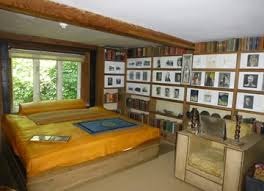

His end came all to soon. Riding his motorbike one evening, he had to suddenly swerve to avoid hitting boys belting along on bicycles. He crashed his bike, sustaining a head injury that killed him several days later. He was only forty-six.
The mourners at his funeral at St. Nicolas' church in Moreton read like a who's who of the 1930s: Winston Churchill, Siegfried Sassoon, Augustus John, Lady Astor and E.M. Forster to name just a few. His mother and one of his brothers were travelling in China at his death, and only one brother was able to attend.

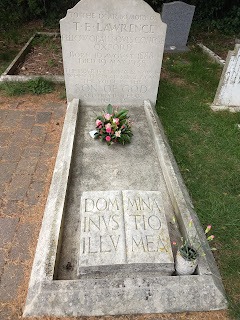
The small cemetery is down the road from the church itself. You enter via a stone portico and take a short stroll through unassuming graves to the back, where Lawrence's resting place is, not ostentatious, but still notable for its size compared to the others. There was a steady stream of visitors, some there just because it was a place of note in the tiny village, others, like me, who made a pilgrimage, and who perhaps, also like me, said a silent prayer that he found peace at last.
Lawrence's mother chose that he be remembered as a scholar rather than soldier and statesman, and his headstone bears the motto of Oxford University, and is from Psalm 27: the Lord is my light.
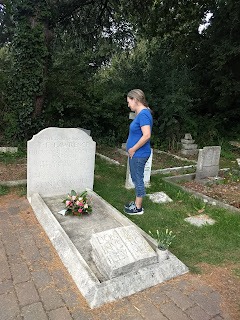

The church at Moreton was bombed in World War II, so I can't claim it is intimately associated with Lawrence, but it is notable in its own right for the etched glass windows chosen to replace the stained glass lost, designed by Sir Laurence Whistler. A traditionalist, the idea of 'plain' glass in the church had me wrinkling my ecclesiastical nose, but I went anyway.
And I was amazed. I could never have predicted how beautiful the glass looks, with the simple background of the countryside, the nave of the church painted a plain sky blue to echo the view. Photos cannot do the church justice - you need to see the windows in situ. (The church website used to have a photo gallery, sadly removed since I updated this blog post.)
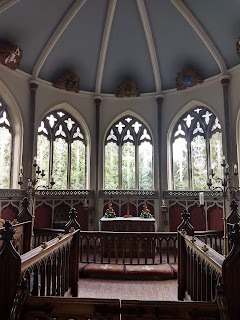

One of the most stunning is the Forgiveness window. Nestled at the back of the church, it is behind a screen and can't been seen from the inside. If you step outside and around the church, however, you will see a hanging Judas Iscariot at the moment of death, with the divine light shining down upon him. Apparently the artist designed this window, the thirteenth, early on, but it took many decades for the church to finally agree to install it.
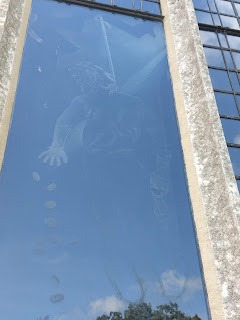

Moreton has a new gem, too: a five-acre walled garden/nursery that is a secret garden of little rooms. It is run to offer training to students with various special needs. There is a small farm and playground to entertain children, plus a cafe. We loved exploring the grounds, but didn't check out the cafe. Instead, we went to the tea rooms situated in the old school house and had a lovely tea. I discovered later, and wished I had known then, that the tea trolley is the bier that carried Lawrence's coffin. Not sure what I think about that. A shout out to their niceness: Alcuin slipped while climbing onto his chair, and even though it was not the cafe's fault, the proprietor gave him his choice from the ice cream cabinet.
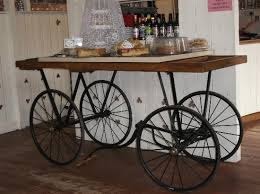

Tourist notes. The place is tiny, so everything is close together. Summer is better to visit as the tea room at least is shut in winter, and the walled garden won't be at its best, though I bet the church windows would be stunning in a frosty landscape with the winter sun. Also, there was a small field open as a free car park, whereas at other times of the year you would probably be parking on the side of the road. There is a railway station a good walk away and some bus connections. Or, you can have very kind parents who drive you there and mind your child while you take in your fill of the place.
